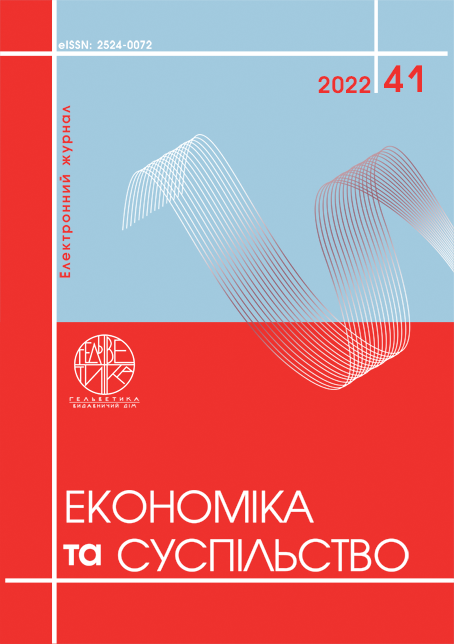CLUSTER APPROACH TO THE DEVELOPMENT OF WINE TOURISM: FOREIGN EXPERIENCE AND POSSIBILITIES OF ITS IMPLEMENTATION IN UKRAINE
Abstract
The proposed article states that a cluster is a sectoral and/or territorial voluntary association of organizations that closely cooperate with each other, as well as with other entities in the value creation chain, with the aim of increasing the competitiveness of their own products, their export, and promoting the economic development of the region. It is noted that the clustering of the economy has long been a way to ensure the effectiveness of the territorial organization of social development. The peculiarities of cluster structures in the field of tourism are clarified: unlike others, tourist clusters are dependent on the sources of tourist resources, which are used to meet the needs of the population for rest and recreation, and can be interpreted as artificial. It has been established that the first tourist clusters emerged at the turn of the 1980s and 1990s in the USA and only later spread to other countries in Europe and the world. From that time until now, wine clusters have been the most effective and now dominant in tourism. The experience of functioning of the leading foreign wine clusters (USA, Chile, France) is analyzed. The organizational structure of clusters is considered, the first level of which forms the core of the cluster, the second level – auxiliary companies, and the third level – service companies. A short excursion into the genesis of winemaking in Ukraine was made and its current state was studied, the existing potential and opportunities for starting wine clusters in Ukraine for the activation of wine tourism were analyzed. The problems, the solution of which can ensure the establishment of wine cluster structures in Ukraine, are identified. It was noted that for the formation of clusters and their development in Ukraine, there is an acute lack of coordinated actions of all those who can participate in their initiation and development: from state authorities to the private sector. Appropriate management personnel, review and finalization of regulatory support for the activities of cluster structures, as well as proper state support and assistance policy are also necessary, etc.
References
Національна програма кластерного розвитку до 2027 року. 74 с.
Данько Н.І. Формування туристичного кластеру як шлях економічного зростання регіону. Вісник Харківського національного університету імені В. Н. Каразіна. Серія: Міжнародні відносини. Економіка. Країнознавство. Туризм. 2014. Т. 1. Вип. 3. С. 157–161. URL: http://international-relations-tourism.karazin.ua/themes/irtb/resources/206ea8db654afba516a7fd4c01ed05c7.pdf (дата звернення: 14.07.2022)
Маслиган О.О., Дичка М.В. Зарубіжний досвід кластеризації сфери рекреації та туризму. Науковий вісник Ужгородського університету: Серія: Економіка. 2012. Вип. 2 (36). С. 260–266.
Виноробний кластер. Каліфорнія. США. URL: https://www.eno.org.ua/vynorobnyi-klaster-kaliforniia-ssha/ (дата звернення: 14.07.2022)
Винний кластер – як це відбувалось у світі. Чилі. URL: https://www.eno.org.ua/vynnyi-klaster-iak-tse-vidbuvalos-u-sviti-chili/ (дата звернення: 25.07.2022)
Руднєва М.Г. Виноградарсько-виноробний кластер Бордо – суспільно-географічна характеристика. Географія та туризм : наук. зб. 2012. Вип. 23. С. 184–190. URL: http://www.geolgt.com.ua/images/stories/zbirnik/vipusk23/v2340.pdf (дата звернення: 25.07.2022)
Виноробство в Україні: сучасний стан і перспективи. URL: https://agropolit.com/blog/475-vinorobstvo-v-ukrayini-suchasniy-stan-i-perspektivi (дата звернення: 27.07.2022)
Нездоймінов С.Г. Регіональні контури кластерного розвитку винного туризму. Науковий вісник Херсонського державного університету. Серія: Економічні науки. 2014. Вип. 8. Ч. 1. С. 136–141.
Natsionalna prohrama klasternoho rozvytku do 2027 roku [National program of cluster development until 2027]. (in Ukrainian)
Danko N.I. (2014) Formuvannia turystychnoho klasteru yak shliakh ekonomichnoho zrostannia rehionu [Formation of a tourist cluster as a way of economic growth of the region]. Visnyk Kharkivskoho natsionalnoho universytetu imeni V.N. Karazina. Seriia: Mizhnarodni vidnosyny. Ekonomika. Krainoznavstvo. Turyzm [Bulletin of Kharkiv National University named after V.N. Karazin. Series: International relations. Economy. Local studies. Tourism], vol. 2, no. 1, рp. 157–161. Available at: http://international-relations-tourism.karazin.ua/themes/irtb/resources/206ea8db654afba516a7fd4c01ed05c7.pdf (accessed 14 July 2022)
Maslyhan O.O., Dychka M.V. (2012) Zarubizhnyi dosvid klasteryzatsii sfery rekreatsii ta turyzmu [Foreign experience of clustering in the sphere of recreation and tourism]. Naukovyi visnyk Uzhhorodskoho universytetu: Seriia: Ekonomika [Scientific Bulletin of Uzhhorod University: Series: Economics], vol. 2 (36), pp. 260–266.
Vynorobnyi klaster. Kaliforniia. SShA [Wine cluster. California. USA]. Available at: https://www.eno.org.ua/vynorobnyi-klaster-kaliforniia-ssha/ (accessed 14 July 2022)
Vynnyi klaster – yak tse vidbuvalos u sviti. Chyli [Wine cluster - how it happened in the world. Chile]. Available at: https://www.eno.org.ua/vynnyi-klaster-iak-tse-vidbuvalos-u-sviti-chili/ (accessed 25 July 2022)
Rudnieva M.H. (2012) Vynohradarsko-vynorobnyi klaster Bordo – suspilno-heohrafichna kharakterystyka [Bordeaux wine-growing cluster – socio-geographic characteristics]. Heohrafiia ta turyzm: nauk. zb. [Geography and tourism: Science. coll.], vol. 23, pp. 184–190. Available at: http://www.geolgt.com.ua/images/stories/zbirnik/vipusk23/v2340.pdf (accessed 25 July 2022)
Vynorobstvo v Ukraini: suchasnyi stan i perspektyvy [Winemaking in Ukraine: current state and prospects]. Available at: https://agropolit.com/blog/475-vinorobstvo-v-ukrayini-suchasniy-stan-i-perspektivi (accessed 27 July 2022)
Nezdoiminov S.H. (2014) Rehionalni kontury klasternoho rozvytku vynnoho turyzmu [Regional contours of cluster development of wine tourism]. Naukovyi visnyk Khersonskoho derzhavnoho universytetu. Seriia: Ekonomichni nauky [Scientific Bulletin of Kherson State University. Series: Economic Sciences]. vol. 8, no. 1, pp. 136–141.


